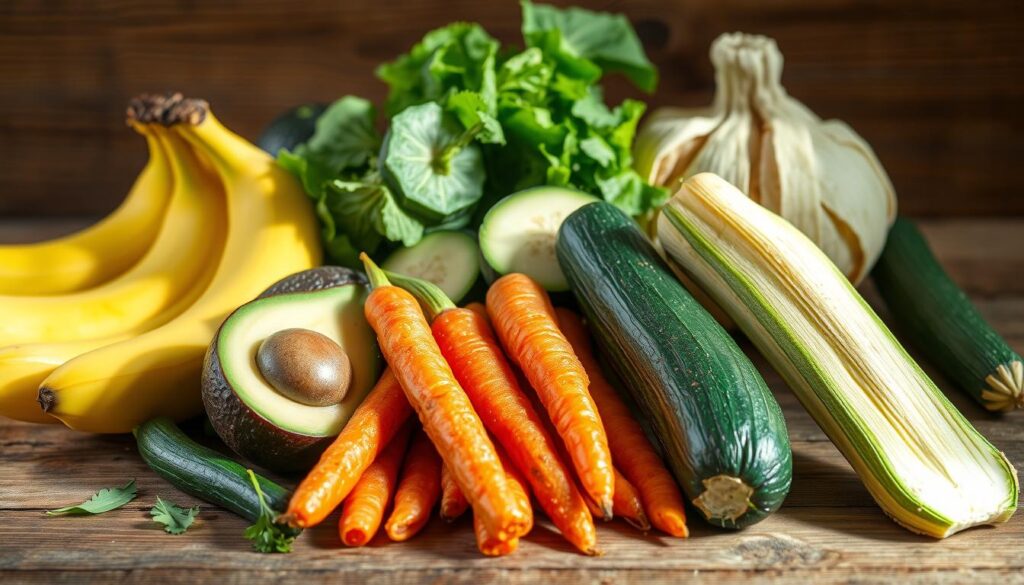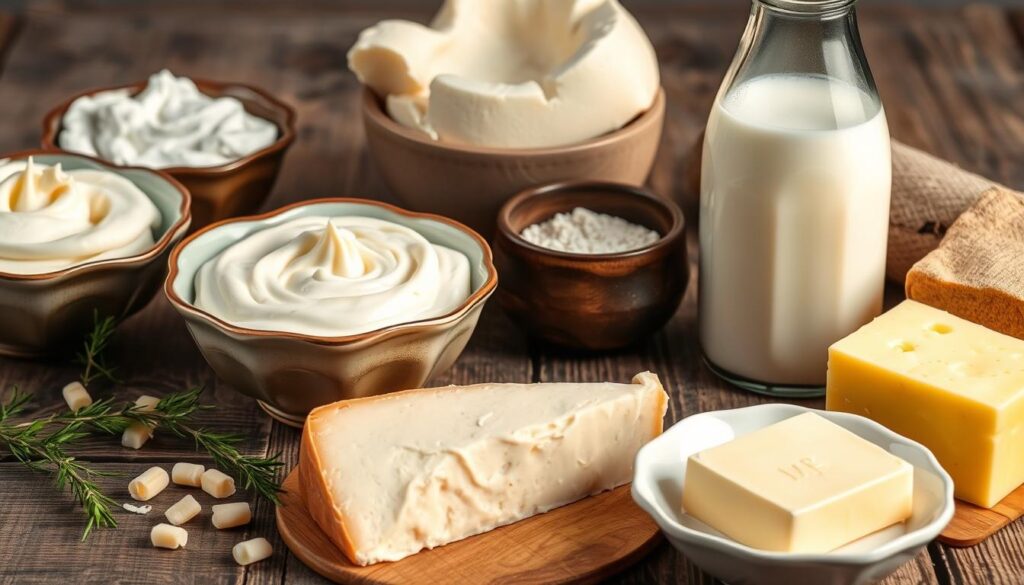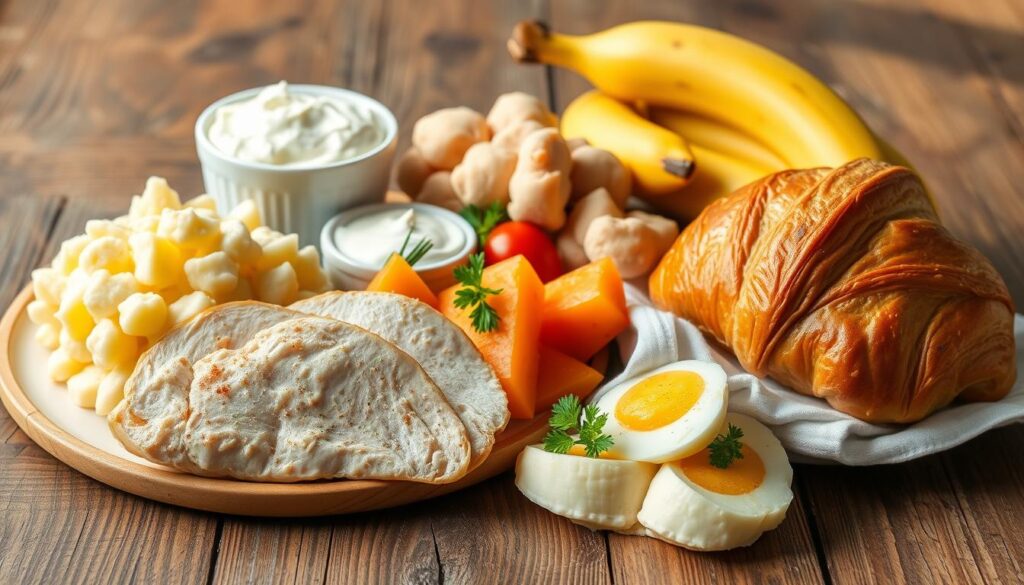When your digestive system is sensitive or irritated, it’s key to eat non high fiber foods. These foods are easier on your gut. A diet low in fiber, about 10 grams a day, can help. It makes moving through your intestines easier, helping with IBS or after bowel surgery.
A low-fiber diet isn’t for losing weight long-term. But it can help your digestive health for a while. Knowing which non high fiber foods to eat can help your body and give your gut a break.
Key Takeaways
- A low-fiber diet limits fiber intake to around 10 grams per day to ease digestive system workload.
- This diet is often recommended for conditions like IBS or recovery from bowel surgery, not for long-term weight loss.
- Focusing on non high fiber foods can provide relief for sensitive digestive systems.
- Refined grains, tender proteins, and certain dairy products are examples of low-fiber options.
- Avoiding high-fiber foods and managing your diet during recovery are important considerations.
Understanding Low-Fiber Diets and Digestive Health
If you have digestive problems like Crohn’s disease or ulcerative colitis, your doctor might suggest a low-fiber diet. This diet helps your stomach by limiting fiber to 10-15 grams a day.
What is a Low-Fiber Diet?
A low-fiber diet means eating foods with less than 2 grams of fiber per serving. You’ll avoid whole grains, raw fruits, and veggies. Instead, you’ll eat white bread, white pasta, and cooked, peeled fruits and veggies.
Benefits for Digestive System
This diet can ease symptoms like belly pain, diarrhea, and other GI problems. It’s good for people with Crohn’s disease, ulcerative colitis, or after bowel surgery.
Who Should Follow This Diet?
People with inflammatory bowel diseases, before a colonoscopy, or with bowel obstruction might also need it. Always talk to your doctor about this diet to make sure you get enough nutrients.
Remember, a low-fiber diet is only for a short time. Once your symptoms get better, your doctor will help you add more fiber back into your diet. This keeps your gut healthy in the long run.
Key Principles of Following a Low-Fiber Food Plan
Following a low-fiber diet helps with digestion and gut health. It can ease symptoms like cramps, bloating, and diarrhea.
Stick to foods with less than 2 grams of fiber per serving. Avoid whole-wheat, legumes, nuts, seeds, and high-fiber fruits and veggies. Instead, choose white bread, white rice, and pasta.
Peeling fruits and veggies can make them easier to digest. Also, drink 8 to 10 cups of water a day to avoid constipation.
- Limit total daily fiber intake to 12 grams or less
- Choose foods with less than 2 grams of fiber per serving
- Peel fruits and vegetables to reduce fiber
- Stay hydrated by drinking 8-10 cups of fluids daily
Work with a dietitian or doctor to follow this diet safely. They can help make sure you get all the nutrients you need. With their help, a low-fiber diet can improve your digestion and health.
Non High Fiber Foods for Better Digestion
When you have digestive issues, eating non-high fiber foods can help. These foods are easy to digest and don’t upset your stomach. They include refined grains, tender proteins, and dairy products.
Refined Grains and Cereals
Choose white bread, pasta, and rice instead of whole grains. These foods are soft on your stomach. Also, pick refined cereals over whole grain ones.
Tender Proteins
Go for soft proteins like eggs, chicken, and fish. Stay away from tough meats. They’re hard for sensitive stomachs.
Dairy Products
Milk, yogurt, and cheese are okay in a low-fiber diet. Watch how your body reacts to lactose. Choose low-lactose or lactose-free if you can. Yogurt is good because it has probiotics.
Eating these foods can help your digestion. Listen to your body and adjust as needed. This way, you’ll find what works best for you.
Safe Fruits and Vegetables for Sensitive Digestion
If you have sensitive digestion, pick safe fruits and veggies. Some foods can upset your stomach. But, there are many gentle and healthy choices.
For a low-fiber diet, choose canned or cooked fruits and veggies. Bananas, melons, peeled apples, carrots, beets, and green beans are good. Potatoes without the skins are also great. And, try strained vegetable juices without pulp.
But, stay away from raw veggies. Cruciferous veggies like broccoli and cauliflower are tough. Also, avoid fruits with seeds or hard skins. They can be hard to digest and make you uncomfortable.
Gentle Fruit and Vegetable Options
- Bananas
- Melons
- Peeled apples
- Carrots
- Beets
- Green beans
- Potatoes (without skins)
- Strained vegetable juices
Foods to Avoid
- Raw vegetables
- Cruciferous vegetables (broccoli, cauliflower, etc.)
- Fruits with seeds or tough skins
Choosing safe fruits and veggies can help your body. It’s about finding the right foods for your sensitive stomach.

Recommended Protein Sources on a Low-Fiber Diet
On a low-fiber diet, choose lean and easy-to-digest proteins. This helps your body get what it needs without upsetting your stomach. We’ll look at the best protein choices for a low-fiber diet, from animal to plant-based options.
Animal Proteins
Lean meats like ground beef, chicken, and turkey are great. Fish and shellfish, such as tilapia and shrimp, are also good. Eggs, whether scrambled or in omelets, are a flexible and low-fiber option.
Plant-Based Options
Vegetarians and vegans can enjoy smooth peanut butter for protein. Tofu, tempeh, and edamame offer 12–20 grams of protein per 3.5-ounce serving. They’re good plant-based choices.
Preparation Methods
When cooking proteins, bake, broil, or poach with light seasonings. Stay away from processed meats and tough cuts. Legumes are also high in fiber and hard to digest.
Adding these low-fiber proteins to your diet helps you stay nourished. It also supports your digestive health when you’re sensitive or recovering.
Dairy and Alternative Products
Dairy products can be good for a low-fiber diet. You can have milk, chocolate milk, yogurt, cheese, cottage cheese, and ice cream without nuts. These can be in desserts, snacks, or main dishes.
But, eat dairy in small amounts. It might upset some stomachs. Watch how you feel after eating dairy.
There are also non-dairy options. Try lactose-free milk, soy milk, almond milk, and plant-based milks. You can find dairy-free yogurts, ice creams, and cheeses too.
| Dairy Products | Dairy Alternatives |
|---|---|
| Milk | Lactose-free milk |
| Yogurt (without seeds or granola) | Soy yogurt |
| Cheese | Nut-based cheeses |
| Cottage cheese | Coconut-based yogurt |
| Ice cream (without nuts) | Dairy-free ice cream |
Choose dairy or alternatives that are good for your stomach. Eat them in small amounts as part of a balanced diet.

Beverages and Hydration Guidelines
Drinking the right amount of water is key when you’re on a low-fiber diet. These diets can make you go to the bathroom less. It’s important to pick drinks that are easy on your stomach and keep you hydrated.
Suitable Drinks
- Water – The foundation of healthy hydration. Aim for at least 8 cups (64 ounces) of water per day.
- Clear juices without pulp – Opt for juices that are free of fiber-rich pulp, such as apple or white grape juice.
- Milk – Both regular and lactose-free milk can be part of a low-fiber diet.
- Certain sodas – Some clear, non-caffeinated sodas may be tolerated, but consume them in moderation.
Drinks to Avoid
While staying hydrated is essential, there are some beverages you may want to limit or avoid on a low-fiber diet:
- Fruit juices with pulp – The fiber-rich pulp can be difficult to digest.
- Prune juice – This beverage is high in fiber and can have a laxative effect.
- Beverages with added fiber – These may include some protein shakes or nutritional drinks.
Always talk to your doctor for advice on the best drinks for you during this diet change.
“Proper hydration is essential for overall health, and it’s especially important when following a low-fiber diet. By choosing the right beverages, you can support your digestive system while keeping your body well-hydrated.”
Cooking Methods and Food Preparation Tips
Choosing the right cooking methods is key when you’re on a low-fiber diet. It helps your digestive system get what it needs without stress. Here are some tips to make your meals easier to digest.
Gentle Cooking Methods
Simmering, poaching, stewing, steaming, and braising are great for a low-fiber diet. These methods use moist heat to make food tender and keep nutrients in. Blanching fruits and veggies also helps keep nutrients in and makes them easier to digest.
Baking and Microwaving
Baking or microwaving in a covered dish is also good. These methods cook food dry without adding extra fat or liquid. This is gentle on a sensitive digestive system.
Preparing Produce
Peel fruits and veggies and remove seeds or tough skins. This lowers fiber and makes them easier to digest. Use mild seasonings and avoid adding high-fiber ingredients like whole grains or nuts.
Cooking Grains and Meats
Make sure grains are well-cooked and meats are tender. This makes them taste better and is easier on your digestive tract.
Using these cooking methods and food preparation tips, you can enjoy a low-fiber diet that’s good for your digestive health.
| Cooking Method | Nutrient Retention | Digestibility |
|---|---|---|
| Simmering | High | Excellent |
| Poaching | High | Excellent |
| Steaming | Moderate | Good |
| Baking | Moderate | Good |
| Microwaving | High | Good |
Foods to Avoid During Digestive Sensitivity
If you have digestive sensitivity, watch what you eat. Some foods, especially high-fiber ones, can make things worse. Let’s look at foods you might want to skip.
High-Fiber Foods List
Foods high in fiber can be tough on those with digestive issues. Here are some examples:
- Nuts and seeds
- Dried fruits
- Whole grains, like brown rice and quinoa
- Beans, lentils, and legumes
- Broccoli and cauliflower
- Popcorn and wheat germ
Common Trigger Foods
Other foods can also upset your stomach. These include:
- Spicy foods
- Fatty foods
- Carbonated drinks
Also, watch out for hidden fiber in foods like some dairy and processed items. Always check labels to avoid trouble.
| Food Category | Foods to Avoid | Recommended Alternatives |
|---|---|---|
| Grains | Whole grains, bran, oatmeal, granola | Refined grains like white bread, pasta, and rice |
| Protein | Beans, lentils, nuts, seeds | Tender meats, poultry, fish, eggs, tofu |
| Fruits and Vegetables | Raw vegetables, dried fruits, corn | Ripe bananas, melons, applesauce, canned/cooked veggies |
| Dairy | Milk, yogurt, ice cream (if lactose intolerant) | Lactose-free dairy or non-dairy alternatives |
Everyone’s body is different. Pay attention to how you feel after eating. Talk to a doctor or dietitian to find foods that are good for you.
Managing Your Diet During Recovery
Recovering from a digestive health issue is delicate. Managing your diet is key during this time. As symptoms get better, start adding fiber-rich foods back in.
This helps your digestive system get back to normal. It also makes sure you get all the nutrients you need.
Begin by adding a little bit of high-fiber food each day. Watch how your body reacts. Look for any discomfort, bloating, or changes in bowel habits.
If you notice anything off, adjust how much you eat. Work with a healthcare pro or dietitian to find the right pace for adding fiber. They’ll help make sure you’re getting enough nutrients during this time.
Some good high-fiber foods to try include:
- Whole grains: Like brown rice, whole wheat bread, and oats
- Fruits: Such as berries, apples, and citrus fruits
- Vegetables: Like broccoli, spinach, and Brussels sprouts
- Legumes: Such as beans, lentils, and peas
- Nuts and seeds: Like almonds, chia seeds, and flaxseeds
Slowly adding fiber helps your digestive health. It helps you go back to a diet full of nutrients. Always listen to your body and work with your healthcare team for a smooth recovery.
Conclusion
A low-fiber diet can help with some digestive problems. But, it’s important to follow it only as a doctor says. Fiber is good for us, so we should eat it again when we can.
It’s important to work with doctors to find the right diet for you. They can help you get back to eating foods full of fiber. This way, you can stay healthy and feel good.
By eating foods that are not high in fiber, you can take care of your stomach. This article has tips to help you. Always talk to your doctor and listen to your body.


A Life-Changing Experience with This Weight Loss Supplement (Nagano Tonic)
I’ve always struggled with finding a weight loss solution that actually works for me. Like many, I’ve tried numerous diets, exercise routines, and supplements over the years—some worked for a short time, but nothing ever gave me long-term results. That was until I decided to try the weight loss supplement I found : Link to the Supplement.
From the moment I started using it, I noticed a difference. Not only did I feel more energized, but my cravings also became more manageable. The best part? I started seeing results much quicker than I anticipated! Over the course of just a few weeks, I noticed a significant reduction in belly fat and overall weight loss that I hadn’t been able to achieve before.
What makes this supplement stand out from all the others I’ve tried is how it supports me in my daily routine without any jitters or energy crashes. I’m able to stay focused and motivated, which has made it easier to stay on track with my diet and exercise plan.
This product truly exceeded my expectations, and I feel more confident and healthier than ever before. If you’re struggling with your weight loss journey like I was, I highly recommend giving this supplement a try. It’s been a game-changer for me, and I’m sure it can work wonders for you too!
Contant Them on email .. tonicnagano50@gmail.com
I’ve tried so many weight loss products over the years, but nothing worked like this supplement! Since I started using it, I’ve noticed a big difference in my energy levels and appetite control. In just a few weeks, I’ve lost weight and feel so much better. It’s been easy to stick with, and the results speak for themselves. Highly recommend this to anyone looking to make a real change!
I was skeptical at first, but this supplement has truly made a difference in my weight loss journey. I’ve lost weight without feeling deprived or sluggish. My cravings are under control, and I feel more confident in my body. It’s easy to incorporate into my daily routine, and the results speak for themselves. I’m so glad I gave it a try!
Thanks David, i do use the link to make my purchase. you can get too here http://surl.li/iasppy
wasn’t sure what to expect, but this weight loss supplement has really impressed me! After just a few weeks of use, I’ve already dropped a few pounds and feel more motivated to stay active. It’s helped curb my cravings and boosted my energy throughout the day. I’m excited to keep going and see even better results. Definitely worth trying!
Reach them on tonicnagano50@gmail.com
I’ve tried so many weight loss products, but this one has been by far the most effective. In just a few weeks, I’ve noticed a visible difference in my body and energy levels. It’s helped me stay on track without the constant hunger pangs and cravings. I’m really happy with my progress and can’t wait to see where I’ll be in another month!
This Nagano Tonic has been amazing! In just a few weeks, I’ve lost weight, feel more energized, and my cravings are under control. Highly recommend it!
Thats the link to purchase http://surl.li/iasppy